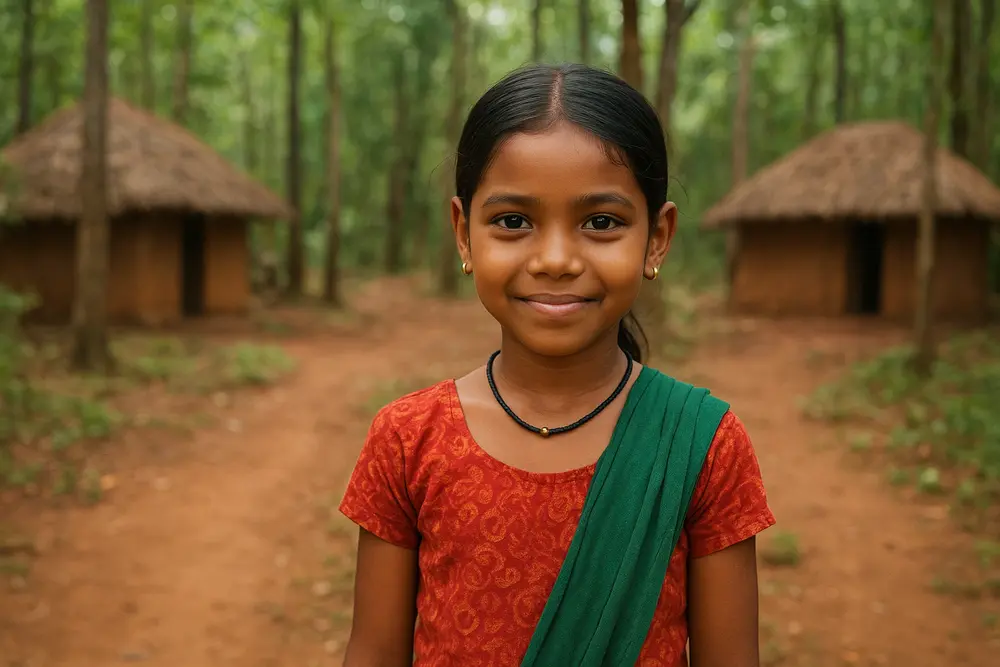Imagine a child in a small tribal village, full of dreams and curiosity, but with no proper school nearby, no internet, and very few teachers.
Education should be their ladder to better jobs, good health, and a brighter future. But when learning stops too soon, the entire community feels the loss—through poverty, poor health, and limited opportunities.
In India’s tribal areas, the lack of education isn’t just about missing classrooms, it’s about missing chances for dignity and growth.
In this article, let’s explore how education shapes—and how its absence affects—tribal communities across India.

How Does Lack of Education Affect Tribal Communities in India in 2025?
Picture a bright, curious 10-year-old girl in a forested hamlet of Odisha. She loves numbers and stories, but the nearest upper-primary school is many kilometres away, teachers rotate in and out, the internet barely reaches her village, and home has no space or light for evening study. Her parents are proud cultivators and gatherers, but the rains are erratic, prices are uncertain, and health shocks can wipe out a whole year’s income.
Education should be her bridge to choices—better jobs, safer motherhood, informed civic participation, and dignified stewardship of land and forests. Yet, for far too many tribal children, that bridge is narrow, broken, or still under construction.
In 2025, India has expanded tribal schooling—hostels, scholarships, residential schools—but gaps remain in learning quality, continuity, and digital access.
Let’s unpack how low and unequal education harms tribal communities—and what is changing—so policymakers, teachers, journalists, and community leaders can push for solutions that actually work on the ground.
The baseline: literacy is rising—but uneven learning limits opportunity
Recent official data show a strong rise in literacy among Scheduled Tribes.
Using Periodic Labour Force Survey (PLFS) estimates, the Government of India reported an ST literacy rate of 72.1% in 2021–22. That’s a remarkable climb from the 2011 census and reflects continued enrolment gains through primary and upper-primary years.
Yet “literacy” here is a threshold, not proof of grade-level mastery in reading, numeracy, or problem-solving.
When foundational skills are weak, young people struggle in secondary school, drop out earlier, or plateau in low-pay work.
These learning deficits also depress returns to later skilling programs, because trainees can’t fully access written content, digital modules, or technical manuals.
As a result, the same family faces a double penalty: fewer formal job options and higher vulnerability to shocks. In practical terms, a Class 8 pass without strong comprehension feels like a brittle credential in competitive labour markets.
Improving attendance, teacher continuity, and language-appropriate textbooks in early grades matters as much as adding more seats in higher classes—because everything compounds from those first years.
Health and survival: less education worsens maternal-child outcomes
Where women have fewer years of schooling, adverse health outcomes are higher.
NFHS-5 (2019–21) consistently shows worse child nutrition and anaemia among ST households than national averages, patterns tightly linked with low maternal education.
Stunting, anaemia, and limited knowledge of reproductive health reduce learning capacity for the next generation—creating an intergenerational trap in which poor schooling today leads to poorer health tomorrow, which then undermines future schooling again.
One NFHS-5–based study found only about 21% of tribal women could correctly identify the ovulatory cycle—an indicator of health knowledge gaps that affect spacing, contraception, and maternal health. Add to this high anaemia prevalence and limited access to timely antenatal care, and the costs of low education become painfully concrete: higher risks in pregnancy, poorer birth outcomes, and lower school readiness in early childhood.
Community-based health education—delivered in local languages and reinforced through schools—can break this loop.
The National Sickle Cell Anaemia Elimination Mission (prioritising tribal belts) adds urgency, but its success will hinge on health literacy as much as on diagnostics.
Work, incomes and mobility: weak schooling narrows livelihood choices
Education is a powerful filter in India’s labour market. With limited schooling, ST youth are more likely to enter informal, low-productivity work with volatile earnings and few protections.
While overall unemployment rates for STs have been modest in recent PLFS rounds, that statistic masks heavy concentration in casual and self-employment and in seasonal, precarious tasks.
Analysts note PLFS improvements but also caution that informality and migration realities are still under-captured, particularly for vulnerable groups. This matters: if surveys under-represent short-term migrants or irregular workers, policy design can miss the real barriers—like credential recognition, safe housing near worksites, or bridge courses to help learners catch up before skilling.
Better foundational learning would expand access to higher-return sectors (construction trades with certification, logistics, formal services, green jobs). But without stronger math, reading, and digital basics, many ST youth end up in the lowest rung of these value chains.
In short, “employment” isn’t enough; the question is what kind of work, with what wage trajectory and safety net. That answer still depends heavily on the quality and continuity of earlier schooling.
A gendered burden: early marriage and low secondary completion
Education delays child marriage and improves maternal-child health. NFHS-5 shows a troubling figure: among women aged 20–24 from Scheduled Tribes, 27% were married before 18—nearly twice the national average of 14.7%.
Girls who leave school early face sharply reduced lifetime earnings and higher risk of early pregnancy and under-nutrition.
Families do value education for daughters, but distance to secondary schools, lack of hostels, safety during travel, and absence of female teachers can push dropout.
When secondary completion is low, scholarship uptake in higher education stalls and vocational programs recruit from a very small female pool.
Targeted measures—safe residential schooling, bicycles or transport support, and local female mentors—work best when combined with clear pathways (e.g., nursing, teaching, IT-enabled roles) that signal tangible returns to families.
Community campaigns in local languages (with mothers as champions) raise awareness about the long-term value of keeping girls in school.
The payoffs multiply—healthier spacing of births, higher child immunisation, better nutrition practices, and greater agency within households and village councils.
Digital divide: when online learning skips the village
COVID-19 pushed education online, but connectivity and device access lag in many tribal areas.
NFHS-5 indicates wide gaps in internet use; for example, only about one-quarter of ST women reported ever using the internet versus roughly half among all women.
Independent reviews also document stark divides in device ownership, data affordability, and digital skills in tribal regions.
When classes, scholarship portals, job applications, and government benefits go digital-first, exclusion multiplies: students can’t join e-classes, parents can’t track attendance or apply for hostels, and youth miss online skilling and exam prep.
Even where phones exist, signal drops and shared devices limit study time. The fix isn’t just towers; it’s public digital infrastructure for learning—community Wi-Fi, school-based labs open after hours, rugged offline-first content in local languages, and digital navigators who help families with applications.
Eklavya Model Residential Schools (EMRS) have begun scaling smart classrooms and computer labs; adapting these models to day schools and hostels can close gaps faster—especially if content and interfaces match the local language ecology.
Higher education: gains in enrolment, but a long road to completion
Expanding access is only step one. The All India Survey on Higher Education (AISHE 2021–22) reports a Scheduled Tribe Gross Enrolment Ratio (GER) of 23.49%—up from 14.5% in 2014–15 and rising faster than the overall GER.
That’s real progress, but GER still trails the national average, and completion rates, especially in STEM and professional programs, remain a concern.
First-generation learners often navigate campuses without strong academic counselling, bridge courses, or peer networks.
Financial aid has expanded (post-matric scholarships, fellowships, “Top Class Education” slots), but delays or complex paperwork can erode persistence.
Mentoring, remedial support in the first year, and internships that connect classroom learning to local economies (forestry, agro-processing, eco-tourism, renewable energy) improve retention.
Colleges near tribal districts can partner with EMRS feeder schools to plan “prep summers,” so entrants arrive with refreshed math, lab skills, and academic English—without losing their home language.
In short, the ladder is taller now; universities need to add sturdy rungs at the bottom and middle so ST students can climb safely to graduation.
School access & infrastructure: why residential models matter
Distance and terrain remain real barriers. That’s why the Eklavya Model Residential School (EMRS) network matters for secondary-senior secondary schooling in tribal belts.
As of August 2025, 479 EMRS are operational, serving about 1.38 lakh students; approvals aim for 728 schools (capacity ~3.5 lakh).
Investment has grown sharply since 2020, with more faculty positions sanctioned and filled each year, plus add-ons like smart classrooms, labs, and skill labs.
Residential schooling can stabilise attendance and protect girls’ schooling in remote areas. But success depends on staffing continuity, culturally responsive pedagogy, and robust transitions: from EMRS to polytechnics/colleges or quality apprenticeships.
For non-residential paths, hostels near good day schools and safe transport are critical.
Finally, content must respect local knowledge—forest ecology, crafts, and languages—so school feels relevant rather than extractive.
Where EMRS models incorporate bilingual instruction and community mentors, dropout falls and aspirations rise—especially for girls who otherwise face long daily walks to school.
Scaling these ingredients beyond EMRS to regular schools and seasonal bridge courses would widen the funnel.
Land, forest rights, and civic capability: education strengthens voice
Education is also citizenship training. Understanding the Forest Rights Act (FRA) 2006, grievance systems, and land records helps communities claim entitlements and resist dispossession.
As of May 2025, government data note 25.11 lakh individual and community FRA titles distributed—a sizable footprint, yet implementation quality and post-title support vary.
Where literacy and legal awareness are low, communities struggle with mapping, objections, and benefit convergence (like credit or irrigation on titled land).
Similarly, the National Commission for Scheduled Tribes (NCST) grievance portal logs thousands of cases each year—evidence of both need and rising rights consciousness.
Investing in school-to-community legal literacy (mock Gram Sabha, reading land maps, understanding PESA where applicable) builds capacity to negotiate with forest departments, line agencies, and private firms.
That civic capability is not “extra”—it protects livelihoods, safeguards sacred groves, and ensures fair compensation when projects arrive.
In short, stronger schooling translates into stronger Gram Sabhas—and more durable development outcomes.
Language & culture: when schooling ignores mother tongues
Many tribal children start school in a language they don’t speak at home. Without mother-tongue instruction in the early years, comprehension lags, confidence dips, and dropout risk rises.
India hosts extraordinary linguistic diversity, and dozens of indigenous languages are classified as vulnerable or endangered in UNESCO’s mapping.
Recent news items and initiatives—like state support to document dialects such as Madiya—show both the risk of language loss and the appetite to preserve it.
Practical steps matter: primers and storybooks in local languages; bilingual teachers; bridging to the regional/state language by Class 3–5; and celebrating oral traditions in school assemblies.
These measures don’t just aid learning; they honour identity and keep ecological knowledge alive (plants, seasons, ceremonies).
When education erases language, it can quietly erode cultural anchors and intergenerational transmission of land-care ethics.
Conversely, when schools centre children’s languages first, attendance and learning jump—and communities perceive school as an ally rather than a threat.
Poverty and vulnerability: why education is the linchpin
India has sharply reduced multidimensional poverty since 2013–14, but tribal communities remain over-represented among the poor.
The World Bank and other development partners repeatedly flag the continued exclusion of tribal populations despite overall national gains.
Poverty and education are tightly coupled: poor households face higher opportunity costs of schooling, and low education locks families into lower-return activities with thinner buffers against shocks.
Health costs (a hospital trip for snakebite, malaria, or sickle cell crisis) can trigger dropout if savings are thin.
Education—especially when combined with scholarships and hostel support—acts like insurance: it increases future earnings, widens access to public services, and improves health knowledge.
To sustain poverty reduction in tribal areas, policies must keep children in school during lean seasons (school meals, conditional cash transfers), smooth transitions to secondary (hostels, transport), and guarantee the last-mile delivery of scholarships on time.
Done right, this blend changes the calculus for families choosing between today’s wage and tomorrow’s degree.
Climate risk, displacement and education continuity
Tribal districts often lie at the frontlines of climate stress—floods, droughts, landslides, and forest fires.
When homes, crops, and access roads are hit, schooling is among the first casualties, especially where schools double as relief spaces and teachers become emergency workers.
Research and reportage increasingly show how environmental disruptions drive migration and language loss, severing young learners from familiar classrooms.
Education systems can harden against these shocks: build climate-resilient schools (elevated plinths in flood zones, cool roofs, rainwater harvesting), pre-position learning kits, and train teachers for rapid “back-to-learning” bridges after closures.
Curriculum can also include local climate knowledge—reading river behaviour, soil health, forest fire breaks—linking science with lived practice.
For students who migrate seasonally with families, flexible enrolment, credit transfers, and hostel seats are crucial to avoid lost years.
The message is simple: climate-proofing education in tribal belts is not a luxury; it’s how we protect a whole generation’s chances amid rising environmental volatility.
What’s working in 2025—and how to scale it
Two shifts stand out in 2025: bigger investments and deeper institutional focus.
The Ministry of Tribal Affairs’ budget and the Development Action Plan for Scheduled Tribes (DAPST) allocations have expanded significantly over the last decade.
The EMRS network adds residential seats, staff, and digital infrastructure; scholarships have reached over 1.56 crore beneficiaries since 2019–20; community rights under FRA continue to be formalised; and new multi-ministry missions target gaps in health, education, and livelihoods in thousands of tribal-majority villages.
The task now is to turn inputs into learning outcomes: bilingual foundational literacy, teacher availability in remote schools, timely scholarship disbursal, and strong school-to-college handoffs.
Partnerships with industry for skill labs and career coaching at EMRS are promising; so are psychometric counselling and exam prep tie-ups.
Replicating these in day schools and hostels—plus last-mile broadband and community digital hubs—can close the urban-rural digital gap.
Finally, track results transparently: attendance, grade-level reading, transition rates, and alumni employment.
When data loops back to Gram Sabhas and School Management Committees, communities can co-steer improvement.
The road through secondary school: retention is everything
Even when enrolment is high in the early years, retention through Classes 9–12 is where many dreams stall.
Government data show ST Gross Enrolment Ratios in primary and upper-primary are strong, but secondary-senior secondary GERs dip—reflecting distance, costs, and perceived payoff.
If a 15-year-old can’t see a bridge from Grade 10 to a specific college course or trade (with stipend/apprenticeship), families default to short-term earnings.
Policy can flip that script: guaranteed hostel seats for girls, universal bicycles/transport in hilly blocks, and stitched-together “pathways posters” in every school that map local colleges, entry requirements, and scholarship deadlines.
Add quarterly parent-teacher circles in local languages to decode exam forms and timelines.
Small nudges—fee waivers for board exam attempts, free re-attempt coaching, and travel support for admit-card days—prevent avoidable dropouts.
Where districts publish school-wise transition rates and celebrate schools that lift ST transitions, peer pressure and pride do the rest.
Retention isn’t a mystery; it’s a system of many tiny doors that must all stay open.
From classroom to campus: making the first year stick
First-generation college students often arrive with aspiration but uneven preparation.
The first year decides everything: students juggle new cities, English-heavy textbooks, and unfamiliar labs.
Colleges serving tribal districts can run pre-semester bridge camps in math, academic writing, and lab safety.
Tie scholarships to structured mentoring so funds arrive with a person, not just a payment.
Align skilling with local opportunity—GIS for forest management, food processing, solar maintenance, community health, and ecotourism operations—so families can see concrete returns.
AISHE shows ST GER rising; sustaining that rise means lifting completion. Where campuses track early-warning signals (attendance dips, unsubmitted assignments) and dispatch tutors quickly, dropout falls.
Placement cells should cultivate smaller, locally relevant employers alongside marquee recruiters—because many ST graduates prefer to work closer to home.
Celebrate bilingualism as an asset: peer-teaching circles where students explain concepts in the home language first, then formalise in English/Hindi, can transform comprehension—and confidence.
Community partnerships: learning beyond the school wall
In many tribal areas, the most trusted knowledge carriers are elders, artisans, forest guards, community health workers, and women’s groups.
Schools thrive when they invite these partners in: monthly “knowledge days,” seed-bank sessions, craft math (measuring, pricing), and forest ecology walks that double as science class.
Linkages with Tribal Research Institutes and TRIFED clusters can turn student projects into community products—packaging, branding, and selling minor forest produce ethically.
Legal-literacy clubs can demystify the FRA and local grievance systems, helping families navigate entitlements.
Where EMRS and day schools open computer labs after hours, youth help elders apply for scholarships or pensions, building digital trust.
These partnerships make schooling feel useful now, not just someday. And they create role models: when a local weaver co-teaches a math lesson on area and cost, students see identity and modernity holding hands, not pulling apart.
That is how attendance turns into attachment—and attachment into achievement.
Data for dignity: measuring what matters in tribal schooling
Better policy needs better data at the right granularity. National surveys and dashboards are improving, but averages can hide the last-mile problems that tribal families face: seasonal migration, teacher vacancies in small schools, and language mismatches in early grades.
Publishing block-level indicators—teacher attendance, mother-tongue availability in Class 1–3, girls’ hostel occupancy, scholarship processing times—helps administrators and Gram Sabhas act quickly.
PLFS tables already disaggregate labour indicators by social group; similar disaggregation in UDISE+ on attendance and transition would spotlight where support is most urgent.
Transparency on grievance redress (like the NCST portal) builds trust when people see cases logged, tracked, and resolved.
The goal isn’t more forms; it’s fewer surprises for parents and students. When families know exactly when results, admit cards, or stipend payments will arrive—and who to call if they don’t—continuity improves.
In education, predictability is a form of respect; for first-generation learners, it can be the difference between staying and slipping out.
Policy coherence: connecting missions, ministries and months
Over the last decade, India has moved from scattered schemes to mission-mode programs targeting tribal development: expanded DAPST funding, residential schools, scholarships, health missions (including sickle-cell), and multi-ministry village initiatives.
The next leap is coherence across the school year: syncing scholarship disbursals with fee deadlines, aligning skill lab calendars with exam cycles, and ensuring hostel repairs happen during vacations.
District collectors can convene monthly “Education Convergence Clinics” with tribal affairs, school education, higher education, skill development, health, and IT departments to clear bottlenecks.
Publish minutes and micro-deadlines so families see the state working in rhythm with their lives (harvests, festivals, migration).
Policy is not just what we fund; it’s when and how predictably we deliver. That reliability makes education a safer bet for families calculating daily wages versus long-term returns—and it’s exactly what recent government backgrounders envisage as funding scales up in 2025.
Read Here: The Impact of Social Class on Educational Attainment
Conclusion: A bridge we can finish—if we build it together
In 2025, India has the resources, institutions, and knowledge to close the education gap for tribal communities.
Literacy has risen, higher-education enrollment is climbing, and residential schools and scholarships are expanding.
Yet the most stubborn barriers are qualitative: early-grade comprehension without mother-tongue support; secondary-level retention for girls; digital access where signal flickers; and first-year scaffolding for college entrants.
Education is the single lever that multiplies every other investment—health, livelihoods, rights, and cultural vitality.
The agenda is practical and urgent: bilingual foundational learning; safe hostels and transport; reliable stipends; community digital hubs; legal-literacy and climate-resilience in the curriculum; and transparent, block-level data that communities can use.
When these pieces click, the 10-year-old girl in Odisha doesn’t just make it to Class 12—she chooses between nursing, forestry tech, or computer science, in her language and on her terms.
That is dignity. And that is how education transforms not only lives, but landscapes.





